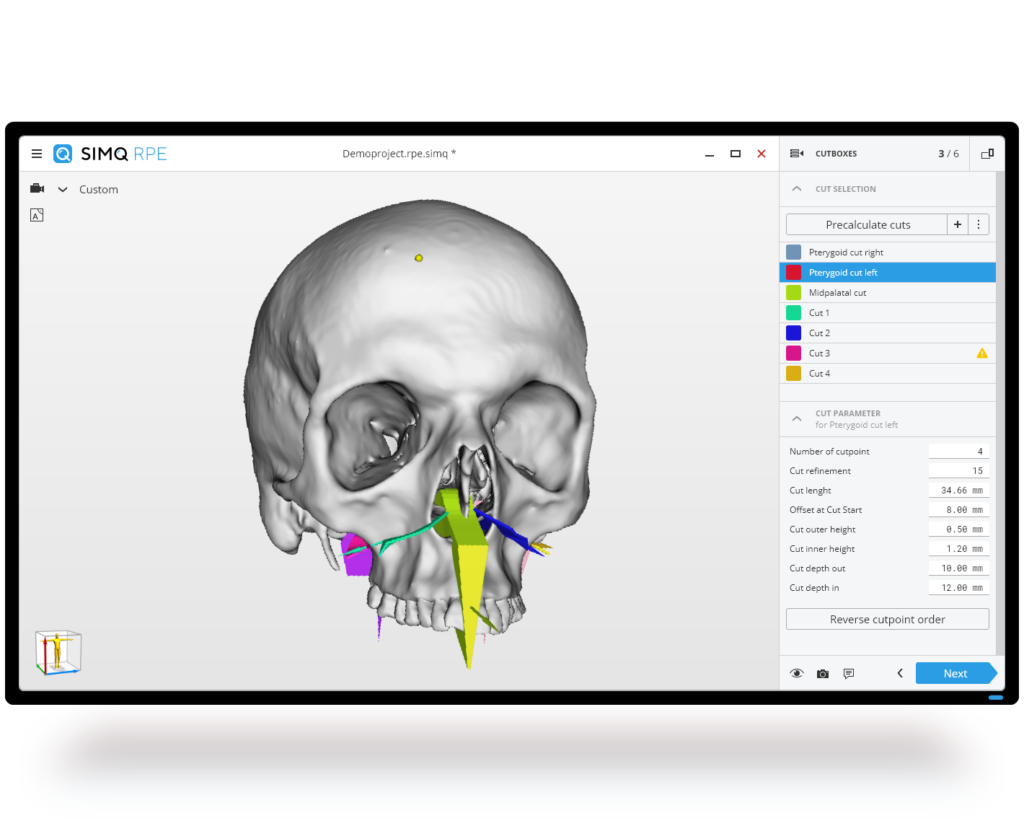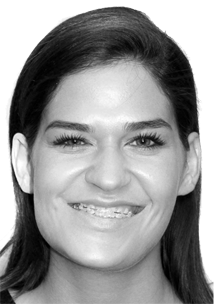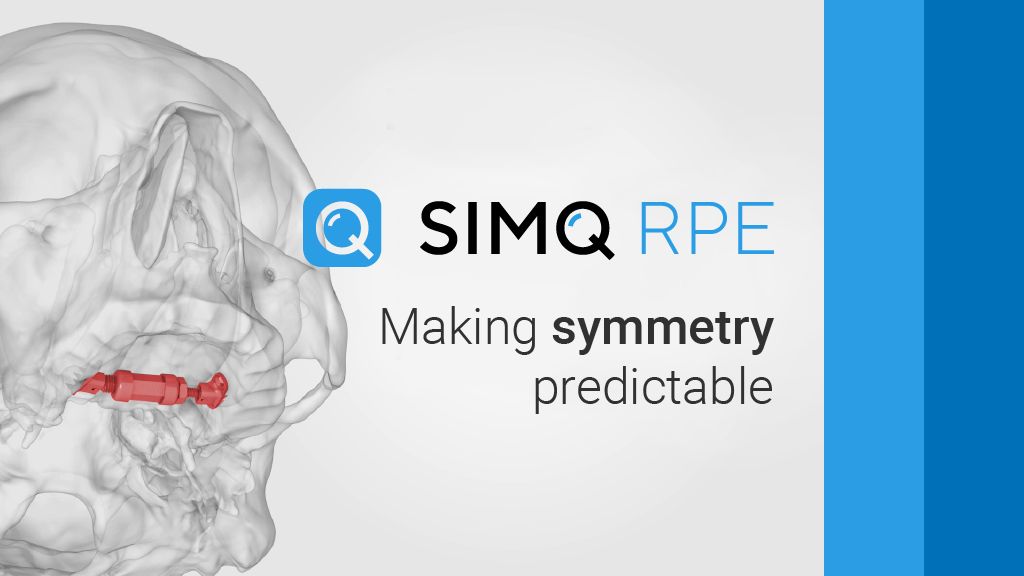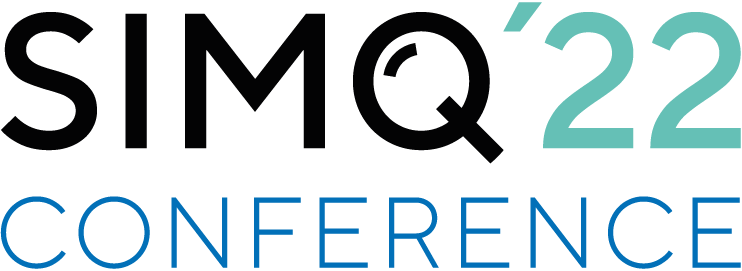Preoperative planning with simulation
Rapid palatal expansion –
achieve symmetrical results

Simq RPE
One of the main risks of rapid palatal expansion (RPE) is that the face is widened asymmetrically by the distractor. This leads to malocclusion of the teeth and a prolonged othodontic treatment.
In collaboration with KLS Martin, we are developing a simulation-based treatment planning tool that can be used to minimize the risk of asymmetric opening. (CE approval coming soon)
Patients treated


Symmetrical outcome
How it works
How it works

Solution approach of the Simq RPE
Challenge of SARME procedure

- Asymmetric anatomy
- symmetric force
- symmetric mobilization
(equal cutting lengths left/right)
- Asymmetric anatomy
Our solution

- Asymmetric anatomy
- symmetric force
- individualized mobilization
(individual cutting lengths left/right)
- Symmetrical opening
Simq RPE at a glance
Target: Development of personalized surgery planning to achieve symmetrical outcome
- Optimal incision guidance through patient-specific simulation
- Advantage physician/manufacturer: billing of individual digital planning covered by the health insurance company
- Positive additional effect for patients: Symmetrical result and fewer or shorter follow-up treatments
- KLS Martin starts commercialization
Get more details
The rapid palatal expansion (RPE), also called forced palatal expansion or rapid maxillary expansion, is an orthodontic treatment of a narrow jaw. With the help of a special distractor in the palate, pressure is applied to the upper jaw.
Stretching with the distractor is usually done with an expansion screw, which the patient can open step by step to stimulate transversal distraction of the upper jaw. According to the instructions of the treating physician, the patient turns the screw slightly 1-3 times a day. The success of the treatment is regularly checked by the doctor.
The resulting stretching stimulates bone growth in the area of the bone suture in the middle of the palate (“palatal suture”) which leads to a transversal bony expansion of the upper jaw.
With children and adolescents, very positive experiences have been made with conventional palatal expansion in particular. The middle suture of the upper jaw is a natural growth plate. No additional surgery is required to expand the upper jaw, since the palate is not yet fully ossified. In children and adolescents, bone growth can thus be stimulated by pressure or stretching in the desired direction.
In adults, ossification is already complete in any case. Therefore, before the maxillary expansion, a palatal expansion surgery for adults is necessary, in which small incisions are made in the upper jaw in order to intentionally weaken it and thus enable the expansion of the upper jaw. This procedure is also called surgically assisted rapid palatal expansion (SARPE).
Due to the constant pressure of the appliance, the upper jaw can thus be expanded by approx. 5 mm in one month.
As soon as the sutura palatina mediana has ossified, the conventional method of palatal expansion is no longer sufficient. According to the literature, the time of complete ossification sets in from around the age of 15 to 16.
In orthodontics, palatal expansion is used in cases of a so-called upper jaw crowding. In this case, the patient’s upper jaw is particularly narrow.
The consequences of a narrow jaw can include the following:
- Misalignment of the teeth (e.g. crossbite) and associated caries and periodontitis
- Snoring and obstructive sleep apnea
- Temporomandibular joint pain
- Obstruction of nasal breathing
There are actually no useful alternatives for palatal expansion. In children and adolescents, depending on the characteristics of the narrow jaw, loose braces can also be used.
This treatment is called slow palatal expansion and is a procedure to expand the maxillary arch in transverse dimension to correct the constricted maxillary arch with light forces.
However, the advantages of a GNE predominate with a significantly shorter treatment period and the minor impairment while speaking.
In rapid palatal expansion, the duration of the procedure varies from patient to patient. The procedure is performed under general anesthesia and lasts approximately 30 minutes. The expansion phase, during which the upper jaw is expanded, typically lasts a few weeks. After that, the distractor remains in the jaw for a few months to support it. This can vary between 6 and 9 months.
Orthodontic treatment to correct the position of the teeth often follows rapid palatal expansion. The main focus here is on occlusion, i.e. the final bite position of the teeth. The treatment is usually completed after 15-18 months. The palatal expansion does not usually entail any disadvantages or restrictions with regard to the jaw apparatus.
The palatal expansion surgery recovery usually takes 2 weeks. Depending on the patient, the recovery period can sometimes be longer.
Rapid palatal expansion is typically used for upper jaw crowding. The crowding can result in a whole range of other consequences. Resulting tooth misalignments make dental and oral hygiene much more difficult. This leads to a higher risk of tooth decay and periodontitis, as well as damage to teeth in general, including tooth loss.
Jaw crowding is often accompanied by a narrowing of the upper airway, which can impede nasal breathing. This, in turn, can lead to snoring and obstructive sleep apnea.
As described, palatal expansion in children does not require surgical intervention and is therefore less invasive.
Palatal expansion is used in both children and adults, but usually not before the age of 4. From around the age of 17, palatal expansion usually has to be supported surgically.
The cost of a RPE depends on several factors such as the size of the defect or the planned therapy.
A rough guide for children is 500-1000€. For adults, who also require surgery, the cost is around 5000€. It should also be noted that children and teenagers can usually expect their costs to be covered by their health insurance.
For adults, however, orthodontic treatments are usually purely private services.
In a before-and-after comparison after successful rapid palatal expansion, changes in the face can usually be seen, as the proportions change.
With conventional treatment methods, asymmetrical distraction often occurs due to symmetrical mobilization. This can not only be visually very annoying, but also usually results in further orthodontic treatment such as braces.
Under the approach of personalized medicine, Simq together with KLS Martin has developed a medical software that guarantees symmetrical distraction. Medical simulation with the Simq RPE preoperative planning software can also be used to specifically optimize the surgical incision. In addition, due to the often shorter incisions during surgery and the blood vessels that remain as a result, the trauma to the patient is lower with this surgical approach.
The experience with palatal expansion for adults using this method has been very positive, both on the part of the patients and the treating physicians.
Partner
Clinic for Oral and Maxillofacial Surgery, Klinikum Dortmund gGmbH, KLS Martin


Articles & publications
- Research Article
Patient-specific pre-operative simulation of the surgically assisted rapid maxillary expansion using finite element method and Latin hypercube sampling: workflow and first clinical results
Computer Methods in Biomechanics and Biomedical Engineering
- Research Article
Evaluation of symmetry behavior of surgically assisted rapid maxillary expansion with simulation-driven targeted bone weakening
Clinical Oral Investigations






